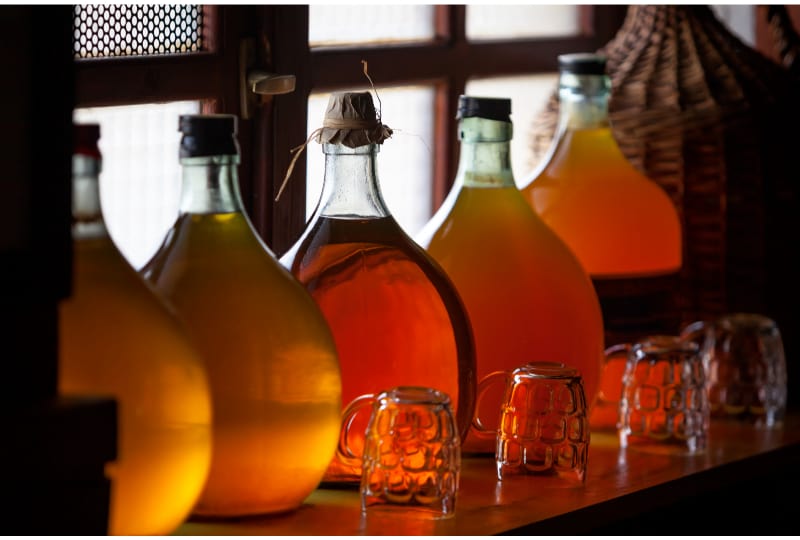The identity of mead can be defined generally by eight features. Any of these topics could form an article in itself so here is a general overview of each element.
COLOUR
A silent observation when I watch people experience our mead is that they first drink with their eyes. It seems an unconscious act but the first element of a mead is colour. And without any additions mead can range from pure white to dark amber. Once fruit or spices are added mead flows like the spectrum of a rainbow. Need a particular colour to complement any meal? You can probably find one.
CLARITY
Linked with colour mead can be brilliant and crystal clear or it can be hazy and unfiltered. Clear or hazy is not an indication of quality or necessarily an indication of aging potential. High clarity generally means that the mead has been filtered which has brightened and sharpened the drink as yeast and bacteria have been removed. In many cases a small amount of protein and other sediments will settle in the bottle. This is generally nothing to be concerned about and adds to mouthfeel (it also can be very nutritious).
AROMA
Now that we have gone beyond the eyes, before anything touches your tongue you’ll experience the aroma. Fruited and spiced meads aside aroma is driven by yeast and honey variety. Honey is a whole topic on its own and the global varieties depend on what the bees worked. Wildflower will be the most prominent and because the bees range wildflower honey is also the most variable honey there likely is. Aroma can range from anything the yeast threw in fermentation to characteristics of the honey. Since taste is in large part smell this element is very important in striking balance. But I have learned what smells ‘right’ to one person is entirely ‘wrong’ to another. Possibly there is some bell curve of smell we all enjoy, but each mead will take on its own aroma.
PLACE
Honey is produced almost everywhere humans live. And honey will never be the same between two harvests. The place of honey will impact the smell and flavour. Craft mead makers will use single varieties and the mead will change batch to batch. Honey can be ‘averaged’ like any agricultural product and blended which is what you’ll find in most honey on supermarket shelves. This element is closely linked to smell, but the honey will have different sugar levels and acid levels making it akin to any agricultural product in variation of time and place.
SWEETNESS
The most common misconception about mead is that it is sweet. Mead exists on every spot of the scale from mouth puckering dry to extremely sweet. Residual sugar adds body so light meads can sometimes taste ‘thin’. If a mead is too dry or sweet you can add honey to the dry mead or a bit of lemon to the sweet mead to bring it into a balance you like.
CARBONATION
Carbonation adds body or cuts sweetness. Meads can be found still, slightly carbonated or highly carbonated like champagne. A mead maker will use carbonation to adjust mouthfeel.
ALCOHOL
Meads range from 2% to 18% (somewhat the limit of natural fermentation). Generally meads under 7.5% are session, traditional is between 7.5% and 14%. Those that are in the 14% to 18% are closer to traditional fortified wines and are typically sweet. But historically meads have been made and consumed along the entire spectrum. The laws of any area help shape the ‘categories’ of mead. Suffice to say what is called mead or session mead in one area is not necessarily the same in another law makers area. Alcohol imparts bitterness to mead so the mead maker will balance this out with other flavours and residual honey.
AGING
As a rule of thumb the higher the alcohol the longer a mead can be aged for. Low alcohol meads can be drunk young (but so can high ones) and I likely wouldn’t keep them for more than a year or two. But it has been our experience with our sessions that so long as they were just honey, water and yeast they just keep getting more complex with age. Unlike wine, meads don’t have vintages. Why? Because honey can be stored and used in different years.
So there you have it. Eight characteristics to generally define mead. We have not even explored the actual spectrum of flavours yet!


